Yes. They could be equivalent. No, they aren't equivalent. It depends. <g>
(to clarify, they circuits aren't really equivalent - my response above is mostly in response to the implied question of, "can I replace this part of a more complex circuit and get equivalent results)
I think a more interesting question is, in your particular circuit, would replacing the 5 resistors hanging off the 5v line with one resistor cause any problems?
(it's been a really long time since I've done any kind of circuit analysis - and only in school - so I might have missed something below)
If you look at the standard MIDI circuit (I used this as an example) and compare it against your circuit diagram, you can see why it's designed the way it is. It appears as though the resistor is there to limit current. The MIDI output circuit has (2) 220 resistors while the input has just 1. When pin 5 of the output goes low current can flow across the opto-isolator from the +5 line on pin 4 (and passes through (3) 220 ohm resistors in series Ra, Rb, Rc in the diagram). If you short any of the lines the various resistors will keep too much current from flowing.
If you take a look at the datasheet for the inverter or the opto-isolator even if you removed the 220 ohm resistor on the +5v side of things you still be within tolerance of the parts (not flow too much current) (but don't do that - a short could cook parts in that case).
So it looks like you could use just 1 resistor in your particular circuit so far.
What about power? How much power will this resistor need to handle?
In the original circuit you've got 5 resistors so if you replace them with a single one this resistor will need to handle 5X the amount of power. Does it matter? Power is P = I * V, and V = 5. To calculate "I", first calculate the total circuit resistance, 220 (5v side) + 220 (pin 5 of the output) + 220 on the input side, so 5 / 660 (I'm going to ignore the 1.2/1.4 voltage drop of the opto; let's assume it shorted) = 7.5mA. P = 5 * 7.5mA = 37mW. 5 circuits * 37mW = 189mW. So it's less than a 1/4 of a watt even with all of them active (although that's not providing a ton of headroom, I'd probably use a 1/2 watt to be safe).
So it looks like you could replace it with a single resistor.
One other consideration - what happens if that 1 resistor fails? If it fails as an open circuit, all 5 ports would stop working. In the original circuit only a single port would be dead. If it shorted, the other resistors in the circuit would probably keep anything from cooking (so you're still safe there), although if you have multiple shorts (between equipment) you'd still cook things, as mentioned above.

